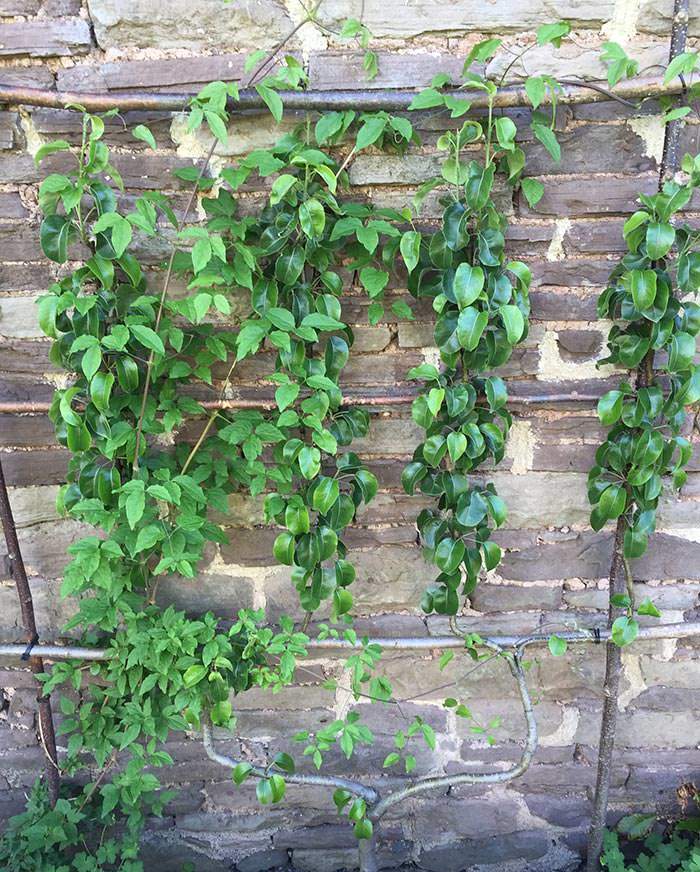The first thing that comes to mind when thinking of autumn is surely the splendid bounty of nature; from magnificent autumn colour of the foliage to abundant harvests of fruits.

Malus Domestica fruiting apple trees
But, in addition to being the season when gardeners get to enjoy the rewards of their hard work, autumn is the time of the year when you need to pay special attention to fruit tree care. One of the most important parts of that process should be preparing your garden for the winter months.
Whether you have an orchard or a few fruit trees in your garden, the process is more or less the same. Fruit tree care in the autumn means getting your plants all set for the next season and protect from the winter elements. Here are our top tips on fruit tree care that will keep your prized plants healthy and high-yielding for years to come!
#1 Help your trees transit to the dormant phase
In late autumn to early winter, fruit trees enter their dormant phase. To make sure that they go into winter sleep well prepared and armed to survive subzero temperatures, never fertilise your trees after June. If you feed them additional nutrients before winter, the trees will continue to grow in cold weather, leaving them vulnerable to frost and serious damage.

Pyrus Communis Conference Pears
Additionally, you should stop watering your fruit trees around the middle of October. They will need to be properly hydrated before they go dormant, though, so before you stop altogether, water enough for it to reach the tree’s root zone.
#2 Pick overripe fruits and remove fallen leaves
If you happen to leave the fruits on the tree’s branches until they are overripe, they might attract pests, such as wasps, or start to rot, leading to another set of potential problems, such as plant fungus and other serious diseases. In addition, as soon as the leaves fall off the tree, you should pick them up and move them away from the tree’s trunk. This part of fruit tree maintenance will ensure that leaf-borne diseases are not contracted again, as well as prevent potential pests hiding away in the leaf pile, wreaking havoc on your garden.
#3 Pruning fruit trees
Young trees should not be pruned in the autumn, as it may leave them exposed to frost damage. If you are pruning fruit trees in the autumn, you are encouraging their growth throughout the winter season, which is particularly dangerous for young trees as they will not have time to harden for the frost. Espaliered fruit trees, too, dislike pruning in the colder season, so best leave this task for the spring.

Many gardeners prefer espalier fruit trees, especially in smaller gardens. As for pruning fruit trees that have been trained this way, it is best to do it in the spring.
However, if you are pruning fruit trees that are already established and hardened, there is a much lower chance of problems. As long as you do not live in an area with particularly harsh winter temperatures, your mature fruit trees should not mind being pruned in autumn. In fact, apple tree care requires you to remove about a fifth of old growth during the dormant phase, to encourage more abundant production next season.
#4 Inspect for pests
Even if you have not had an infestation this year, make sure to properly and thoroughly inspect the tree for traces of overwintering insects. (And if you did have insect troubles, then this step is doubly important.) Autumn fruit tree maintenance would not be complete if you skip on looking for pests and their eggs, which will often be sneakily hidden in the tree’s bark fissures and other hard-to-reach spots. Check for aphids, scale insects, or red spider mites – the last thing you would want is them making a home in your orchard! In addition, when it comes to apple tree care, make sure to include codling moths in your search, as these pesky pests can be successfully eliminated with timely reaction. Failing to prevent pest problems for next season can make fruit tree care much harder than it should be, and even substantially damage your crops.

A crucial part of apple tree care is inspecting the tree for pests that could harm your cultivar’s fruit production.
How you eliminate the insects will depend on the particular species and the type of garden you have: anything from chemical sprays to natural organic solutions could prove to be a good choice.
#5 Rejuvenate your garden with new fruit trees
In addition to being the season when you will have to dedicate your time to fruit tree maintenance, autumn is also the perfect time for planting new varieties to your orchard or garden. When choosing which fruit trees to plant, make sure to check if they are compatible with the existing cultivars (same pollination group). Whether you’re growing juicy plums, aromatic quinces, crisp apples or honey-sweet pears, the trick is to grow varieties that flower at the same time, as it will lead to cross-pollination and increase the yield of fruit your trees produce.
Our vast selection of bare root fruit trees will give you plenty of popular fruit cultivars to choose from, from plums, apples, pears, to quince. All of our plants can be ordered online: we do nationwide delivery! In case you need help with choosing the best fruit trees for your garden, contact us for advice and information – we are happy to help!




